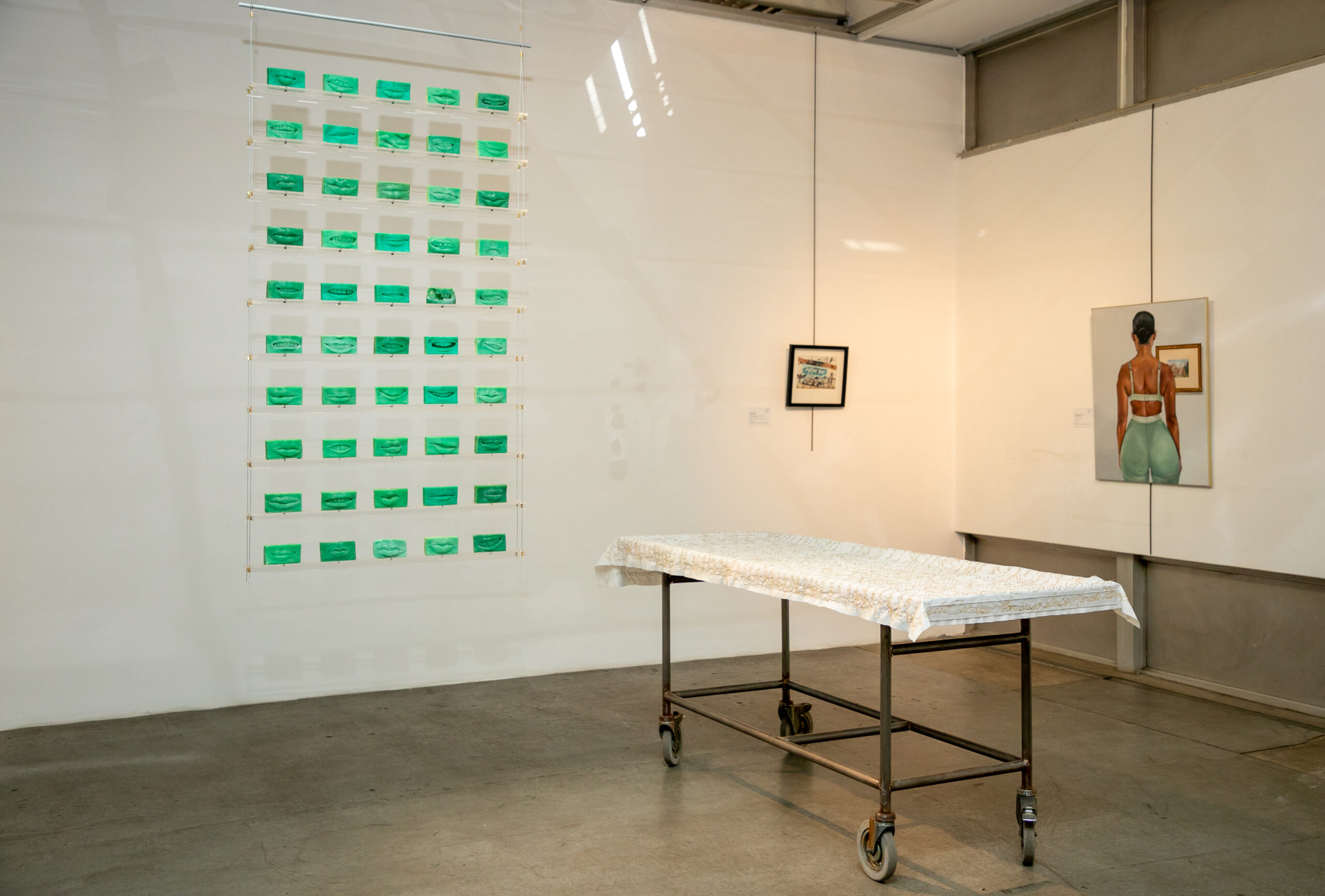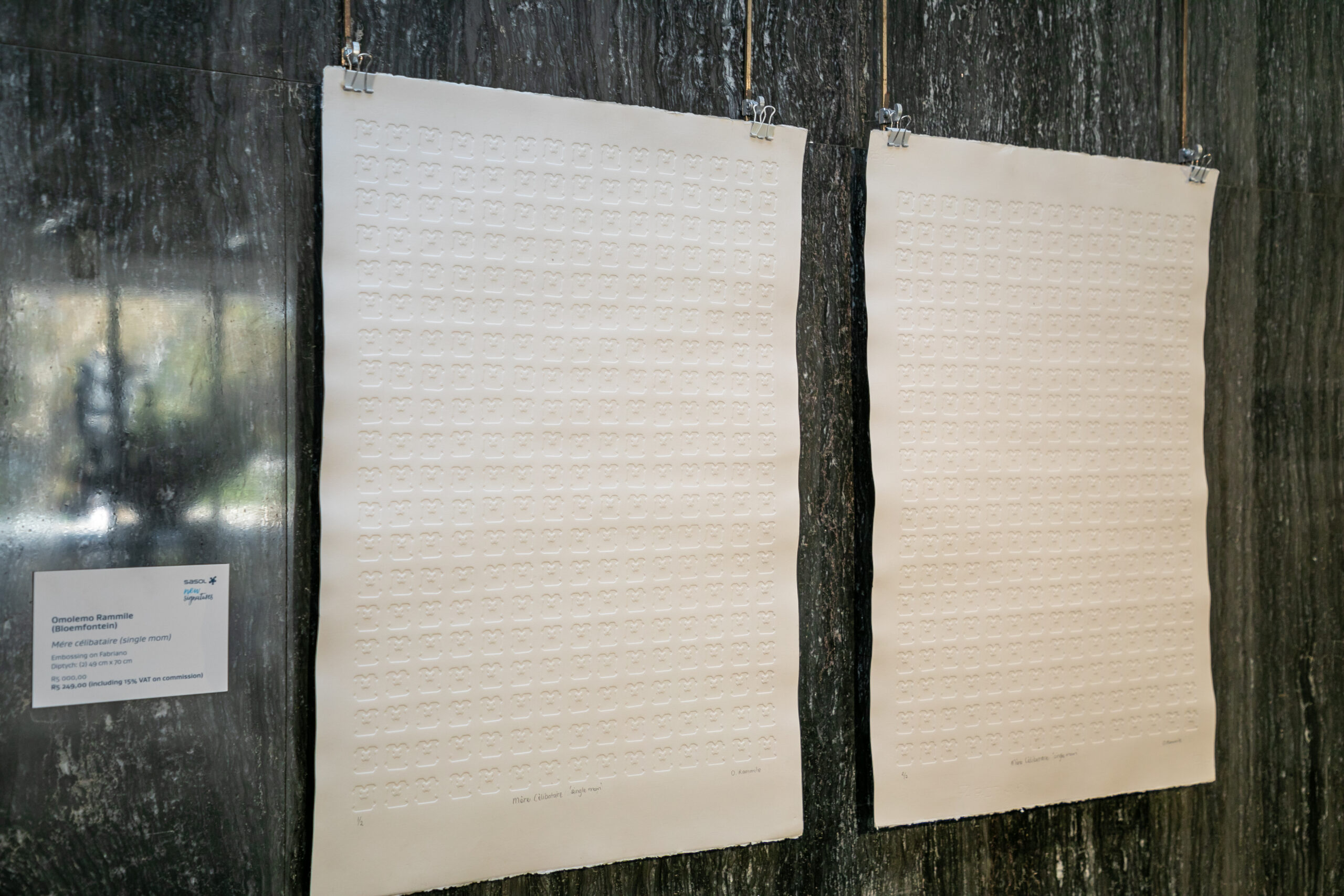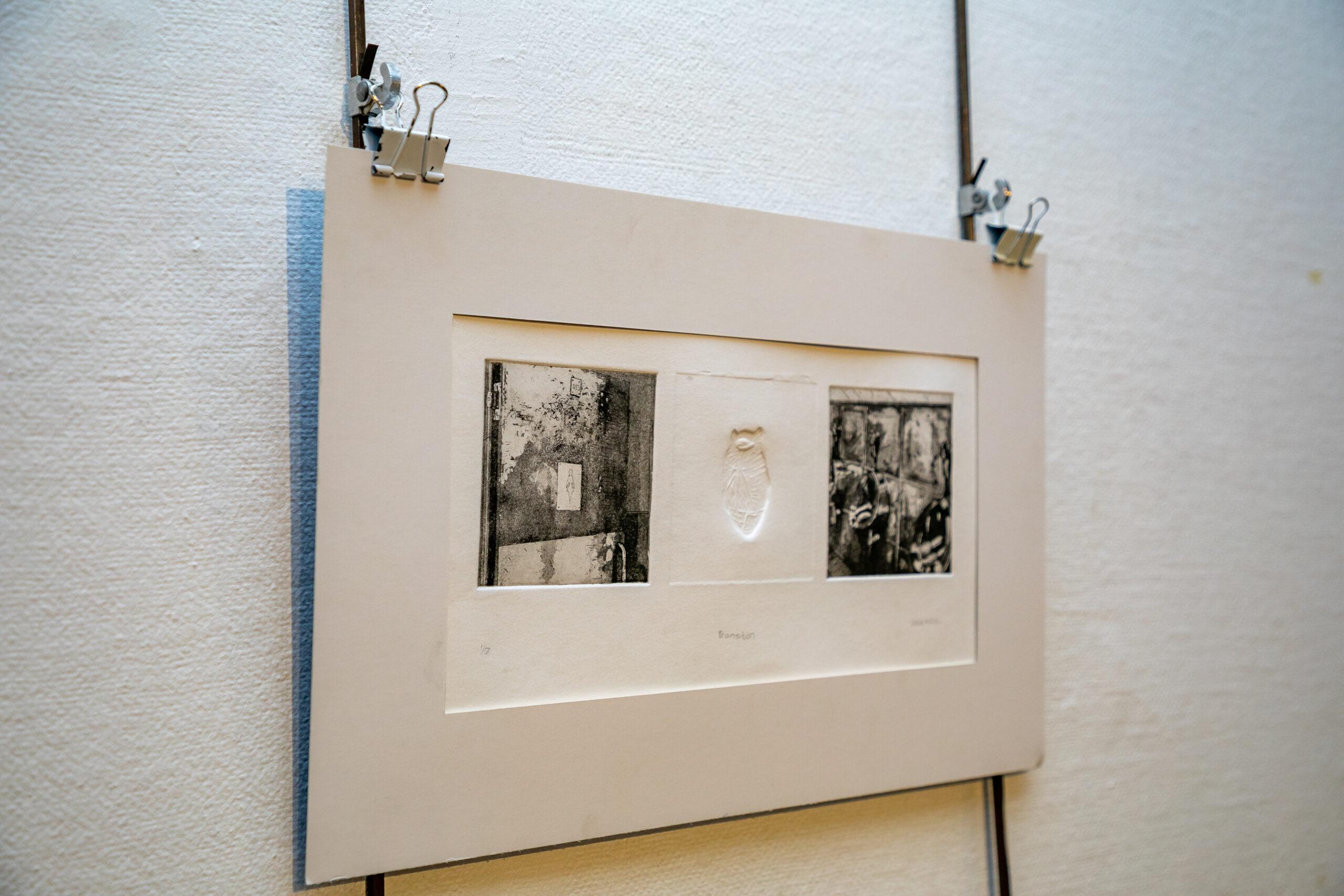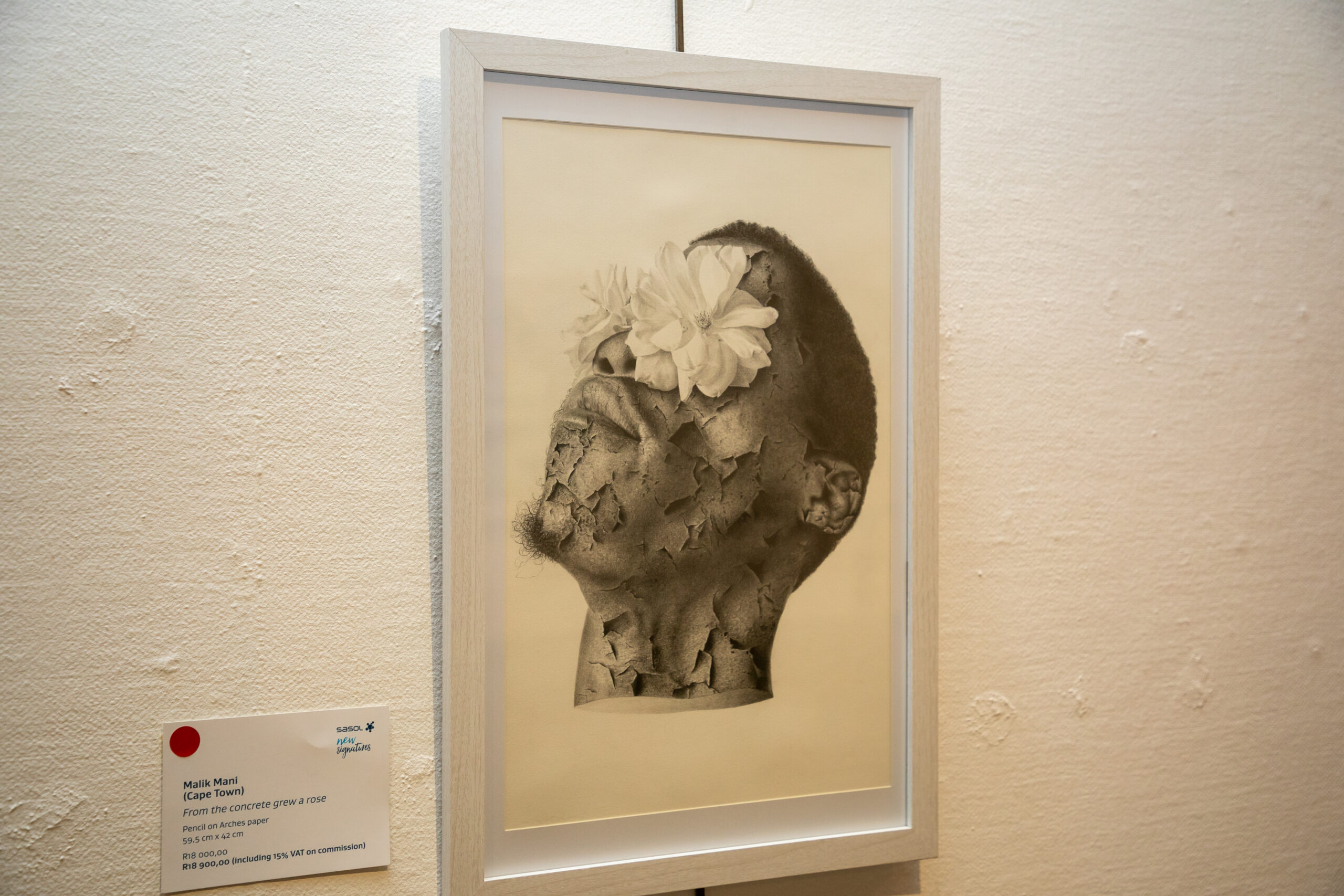#OverMyDeadBody 1
Sunlight soap & Perspex
160 cm x 80,5 cm x 8 cm
#OverMyDeadBody 4
Hospital gurney, embroidered shroud & speaker
87 cm x 197 cm x 85 cm
The #OverMyDeadBody series interrogates the ongoing perception that it is acceptable for a man to punish a woman through violence or death. This series draws attention to the women who have died at their partners’ hands. The processes and media used to honour South African femicide victims are influenced by the artist’s own experiences of intimate partner violence. When a woman, as sufferer or survivor, sees art relating to violence against other women, it provokes an instinctive response: she remembers because she cannot forget. Residual traumatic memory engenders empathy and grievability for these absent yet present women. The artist gathered data and images of femicide victims through various online and offline media. Since green Sunlight soap bars are found in most South African households, the victims’ mouths were carved into the soap. Fifty sculptured mouths are suspended at eye level on Perspex shelves. The passing of the artist’s mother inspired the death shroud embroidered with the victims’ names in gold, which is complimented by a lone singer’s voice that mourns the dead.
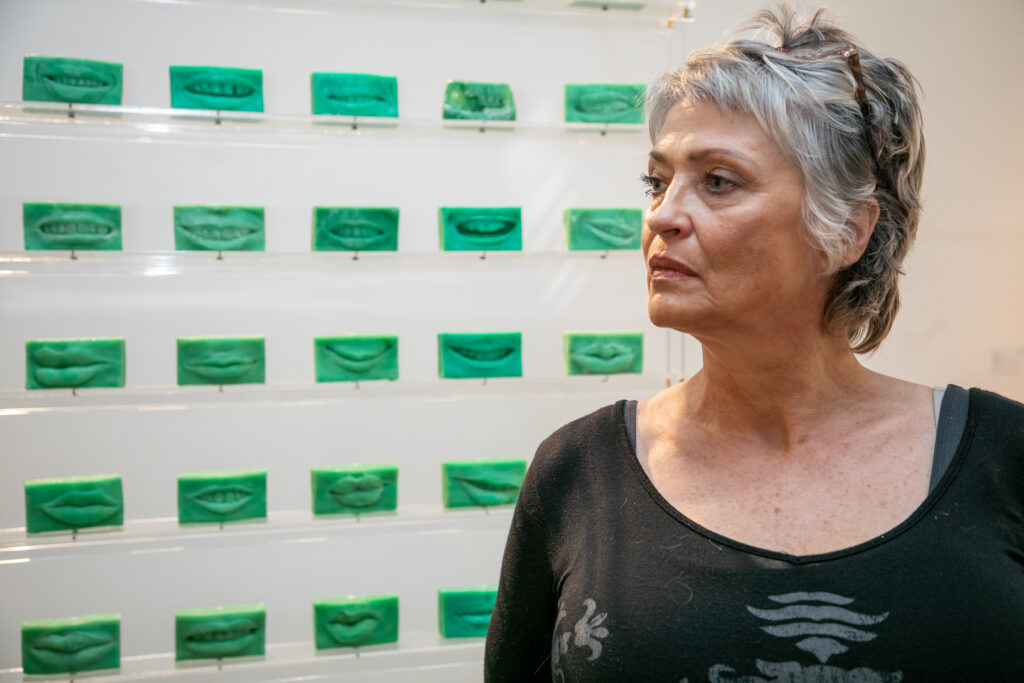
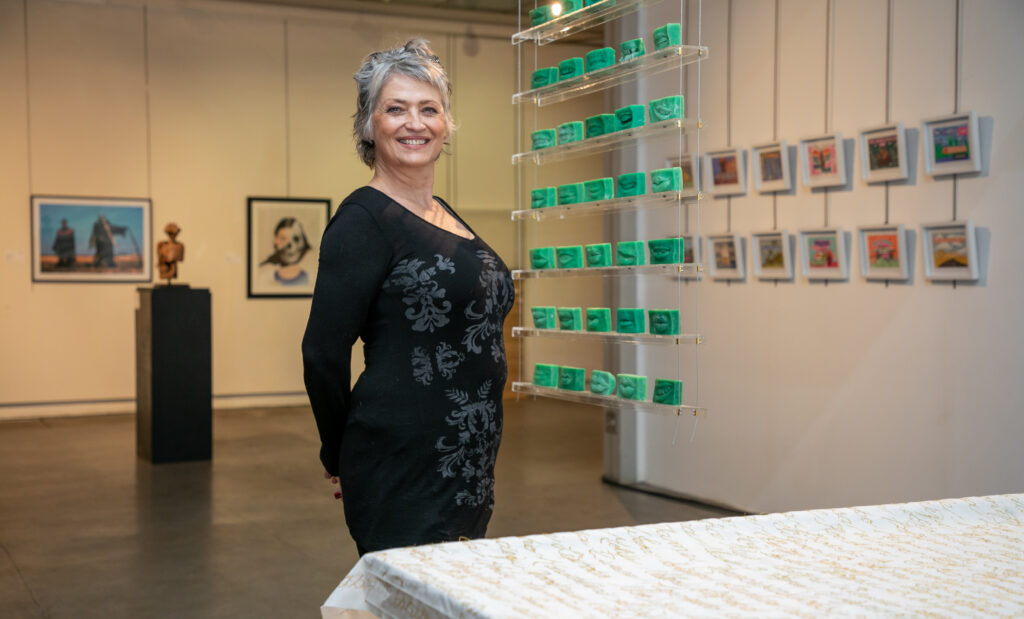
Q&A
Is this the first time you have entered the competition?
Yes, it is the first time I have entered. I only entered because one of my supervisors, Dr Gwen Miller, told me I had to. (Having a reasonable sense of self-preservation, I do as she says!)
Tell us a little about your artistic journey up until entering Sasol New Signatures 2022.
At the age of 50, I started studying visual arts through Unisa. Since I had experienced intimate partner violence over many years, my third-year installation, Vrou Vertaal, served as a personal retrospective. Situated in a black mirrored room, nightclub lighting and a mirror ball reflected red umbrellas, creating shards of light and the frenetic sense of a party gone horribly wrong. The injuries I sustained are embroidered in diamanté on one umbrella, while another is covered by my wedding veil, replete with pearls, fishhooks and text. A third umbrella is covered with Disney couples from a little girl’s party tablecloth. The women’s eyes are covered by black electrical tape. Three fluorescent video texts, explaining, apologising and threatening, meandered across the umbrellas.
When Reeva Steenkamp was shot by Oscar Pistorius in 2013, I decided to interrogate the murder in my fourth-year work. I received Kevlar offcuts supplied by a bulletproof vest manufacturer to SAPS Ballistics in Amanzimtoti. I was told that these remnants are stuffed into large white bags. Weapons recovered from serious crimes are then test-fired into the bags. As a consequence, the Kevlar fragments contain compressed bullets and gunpowder stains. I created a quilt from the fragments, embroidered with Reeva Steenkamp’s last Instagram post: “I woke up in a safe, happy home; not everyone did.” Her message referred to Anene Booysen, who had been gang-raped, disembowelled and left for dead the previous week by her ex-boyfriend and his friends. The Abject of Desire installation included large laser-cut stainless steel medallions. One medallion, surrounded by a wreath of Yesterday, Today and Tomorrow flowers, encloses four ladies’ toilet signs, where they hold hands. At the time, four women were killed daily by intimate partners in South Africa. The others, titled with reference to Pistorius’s sponsor slogans, are: Part man, part god (Thierry Mugler: A*men), My body is my weapon and I am the bullet in the chamber (Nike).
Who has had the biggest influence on your career as an artist to date?
The most influential people as pertains to my career over the years are undoubtedly curator Carol Brown, lecturers Celia de Villiers and Gwen Miller, my friend Karen Pretorius (a previous Sasol finalist), Elaine Mitchell and Melanie Anthony, who bought the medallions from Abject of Desire. These women have unequivocally encouraged and supported my art, helping me in any way they can. I am immensely grateful to them.
Tell us a little about why you created the piece you submitted.
The #OverMyDeadBody exhibition interrogates the ongoing perception that it is acceptable for a man to punish a woman through violence or death. I am compelled to draw attention to the women who continue to die in SA at their partners’ hands. The names keep coming with frightening intensity.
Tell us about your preferred media … and why.
The processes and media I use are undoubtedly influenced by my experiences. Memories are activated by domestic objects or from areas traditionally viewed as women’s spaces. When a woman, as a sufferer or survivor, sees art relating to violence against women, it provokes an instinctive response: she remembers because she cannot forget.
I am delighted that the judges have accepted two components of my Unisa Master’s work, #OverMyDeadBody 1. #OverMyDeadBody 1 comprises 50 Sunlight soap bars suspended on transparent shelves. The mouth of a SA femicide victim is carved on the front, while the back of the soap is inscribed with her name and age at the time of death. Sunlight soap is used in most households, and in some cultures, it is used to prepare bodies for burial.
#OverMyDeadBody II is a mortuary gurney covered by a shroud obtained from a funeral parlour. The names of the victims have been embroidered in gold thread, a labour of love that took two years to complete. This work includes a vocal lament entitled Thula by Johannesburg singer Mariechan Luiters.
When people view your work, what reaction are you hoping to generate?
Being an activist artist, this work was created for people who are perhaps not familiar with the art world, but everyone knows about the terrible violence inflicted on women, especially those who are poverty-stricken and denied social and economic opportunities. A Sangoma and a Hindu psychic visited my exhibition at the Durban Art Gallery and responded very positively. Young male students came to hug me with tears in their eyes while some young women simply cried. As indicated in the visitor’s book, some viewers returned to the exhibition several times. I honestly did not expect this response, but I would hope that people will also engage with my work and think about it at the Pretoria Art Museum.
Why do you think that your work was chosen as a top 7?
I hope that I have been included in the top 7 because my work addresses an important social issue, is original and generates thought and affect.
And if you are chosen as the overall winner? How would you feel? Have you already got an idea or vision for your solo exhibition?
I would be ecstatic. Art-making is not only time-consuming but very expensive. My work is more suited to a museum or academic gallery due to its size, so it would give me the financial freedom to work without worrying. The prestige of being a Sasol New Signatures winner has launched the career of many successful SA artists. I would be thrilled to join such an illustrious group.
2023 will be the tenth anniversary of the deaths of Anene Booysen and Reeva Steenkamp. Reeva Steenkamp was well educated and middle class, while Anene Booysen left school to work as a cleaner in order to help her poverty-stricken family. I am thinking about doing a large-scale remake of The Creation of Adam, where the two protagonists are replaced by Booysen and Steenkamp.
I will use candle wax. Wax is used for ordinary candles used in households without electricity, while the expensive variety are accompanied by flowers and champagne at intimate dinners on Valentine’s Day. I usually do a lot of research, so at this stage, it’s just a mind-sketch.
What are you currently working on? What is next for you as an artist?
I am preparing for a Unisa student workshop that’s generously being hosted by the Durban Art Gallery next week. I am also writing the third chapter of my dissertation. So not much art making until I finish it, unfortunately! I enjoy working with my students and seeing what they are creating.
Which South African artists do you admire and why?
I can’t possibly list all the artists whose work I admire – we will be here until next year! I was very excited to see Gwen Miller’s exquisite expressionist painting in the Sorrows exhibition at the Pretoria Art Museum and a Vusi Beauchamp work I have coveted for ages. I love his crazy style and satirical sensibility.
I also discovered that I am a closet Pierneef fan – the Museum has some gorgeous examples of his work.
Of course, I have loved Gabrielle Goliath’s participatory work since I studied her for inclusion in my dissertation. Goliath focuses on the experiences of black and brown women, the disenfranchised and queer, working with femicide and gender-based violence through multi-track video vocal performances that memorialise victims of rape and femicide.
The iconic Dumile Feni astounds me every time I see his drawings, the black-humoured Anton Kannemeyer who makes us laugh at ourselves even when we don’t want to, sculptor Elizabeth Balcombe’s modern mythology, Athi-Patra Ruga’s magpie sensibility and Celia de Villiers, whose work ranges from resin and steel to sublime reprocessed fabrics … these are really the tip of the iceberg.
Anything else you’d like to add?
I was thrilled when Banyana Banyana won the WAFCON. I was surprised to learn that Sasol has been sponsoring the national women’s team for the past ten years!

